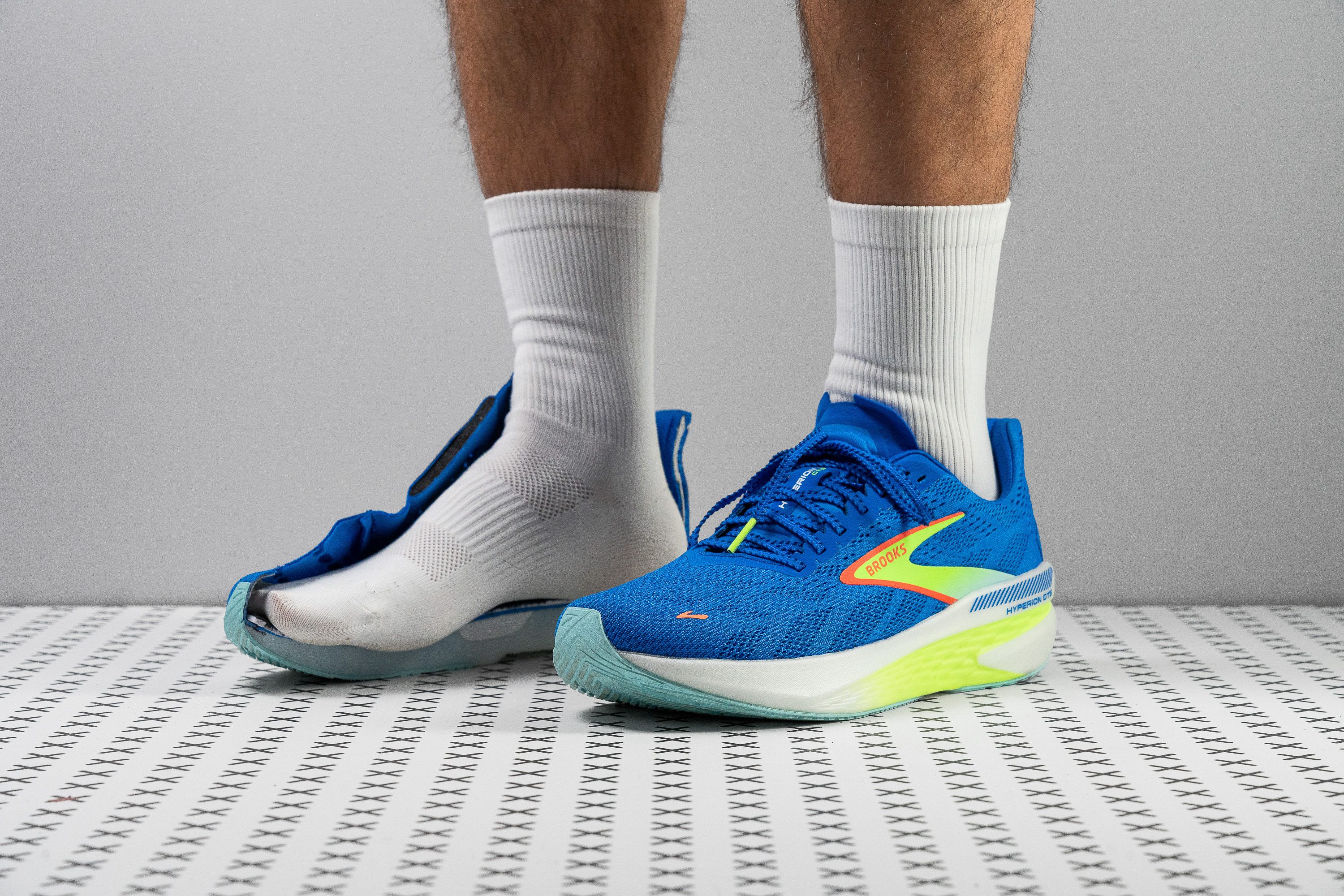Our verdict
Pros
- Lightweight build
- Upgraded DNA Flash v2 midsole
- Versatile for everyday use
- Agile and nimble ride
- Promotes foot strength
- Outsole built for serious mileage
- Secure lockdown
- Reasonably priced
- Reasonably priced
Cons
- Not for long runs
- Foam lacks excitement
- Runs a bit warm in summer
- Higher drop than expected
Audience verdict
- Top 29% in running shoes
- Top 10% in stability running shoes
Comparison
The most similar running shoes compared
+ + Add a shoe | |||||
|---|---|---|---|---|---|
| Audience score | 89 Great! | 87 Great! | 83 Good! | 89 Great! | |
| Price | £140 | £110 | £160 | £130 | |
| Pace | Daily runningTempo | Daily running | Daily running | Daily running | |
| Arch support | Stability | Stability | Stability | Stability | |
| Weight lab Weight brand | 7.8 oz / 220g 7.6 oz / 215g | 10.3 oz / 293g 10.5 oz / 297g | 11.6 oz / 329g 11.3 oz / 320g | 9.8 oz / 279g 9.8 oz / 278g | |
| Lightweight | ✓ | ✗ | ✗ | ✗ | |
| Drop lab Drop brand | 10.7 mm 8.0 mm | 9.8 mm 10.0 mm | 7.9 mm 10.0 mm | 10.0 mm 10.0 mm | |
| Strike pattern | Heel | HeelMid/forefoot | Mid/forefoot | HeelMid/forefoot | |
| Size | True to size | True to size | True to size | True to size | |
| Midsole softness | Balanced | Firm | Balanced | Balanced | |
| Difference in midsole softness in cold | Normal | Small | Normal | Small | |
| Toebox durability | Decent | Decent | Good | Decent | |
| Heel padding durability | Good | Good | Good | Bad | |
| Outsole durability | Good | Bad | Good | Decent | |
| Breathability | Moderate | Warm | Moderate | Moderate | |
| Width / fit | Medium | Medium | Narrow | Medium | |
| Toebox width | Medium | Wide | Medium | Wide | |
| Stiffness | Moderate | Stiff | Moderate | Flexible | |
| Torsional rigidity | Stiff | Moderate | Stiff | Moderate | |
| Heel counter stiffness | Moderate | Moderate | Moderate | Stiff | |
| Heel lab Heel brand | 33.0 mm 34.0 mm | 32.9 mm 31.0 mm | 33.2 mm 31.0 mm | 33.1 mm 36.0 mm | |
| Forefoot lab Forefoot brand | 22.3 mm 26.0 mm | 23.1 mm 21.0 mm | 25.3 mm 21.0 mm | 23.1 mm 26.0 mm | |
| Widths available | Normal | Normal | Normal | Normal | |
| Orthotic friendly | ✓ | ✓ | ✓ | ✓ | |
| Season | All seasons | All seasons | All seasons | All seasons | |
| Removable insole | ✓ | ✓ | ✓ | ✓ | |
| Ranking | #106 Top 29% | #167 Top 46% | #247 Bottom 32% | #108 Top 30% | |
| Popularity | #178 Top 49% | #347 Bottom 5% | #173 Top 48% | #258 Bottom 29% |
Who should buy
In our view, the Hyperion GTS 2 is a good pick for:
- Runners who enjoyed the previous version but were hoping for a foam upgrade.
- Those looking for a lightweight daily trainer that adds a touch of stability without going overboard.
- Fans of shoes that steer away from the chunky-maximalist trend and prefer a feedback-rich, feather-light ride at a fair price.
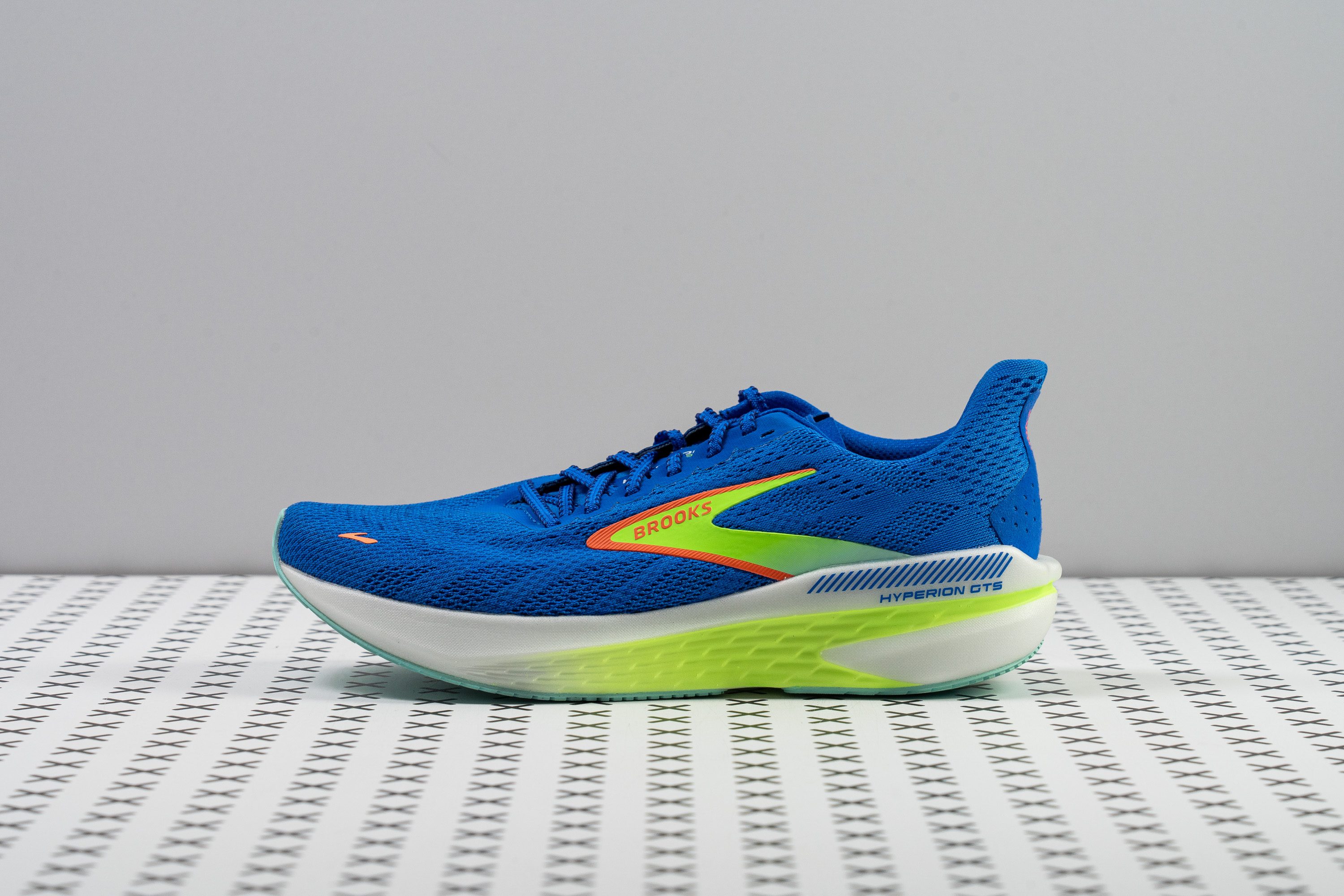
Who should NOT buy
We think the Hyperion GTS 2 isn’t the best option for long runs or runners needing extra protection. Its low-stack setup lacks the deep-cushioned, joint-friendly feel found in long-distance-ready shoes like the ASICS Gel Kayano 31.
In our view, the narrow-and-compact midsole may also be a drawback for heel strikers who rely on a wider base for added stability. We’re convinced that alternatives such as the ASICS GT 2000 13 or the New Balance Fresh Foam X Vongo v6 are safer bets.

Cushioning
Shock absorption
Shock absorption is impressive at 123 SA for a shoe that barely exceeds the 30 mm stack height mark in the heel.

| Hyperion GTS 2 | 123 SA |
| Average | 129 SA |
Energy return
All GTS versions of Brooks shoes tend to have reduced energy return in the heel due to added stability elements, and the Hyperion GTS 2 is no exception, as it scored just 51.8% in the rear. On the other hand, the forefoot feels much more responsive, delivering 59.7% in our test.
| Hyperion GTS 2 | 51.8% |
| Average | 58.6% |
Heel stack
We tested the Hyperion GTS 2 and found that one of its standout features is still the low stack height, which offers a grounded, feedback-rich ride that feels connected to the road.
While Brooks has been pushing their entire lineup upward, this model still stays below the average at 33.0 mm.
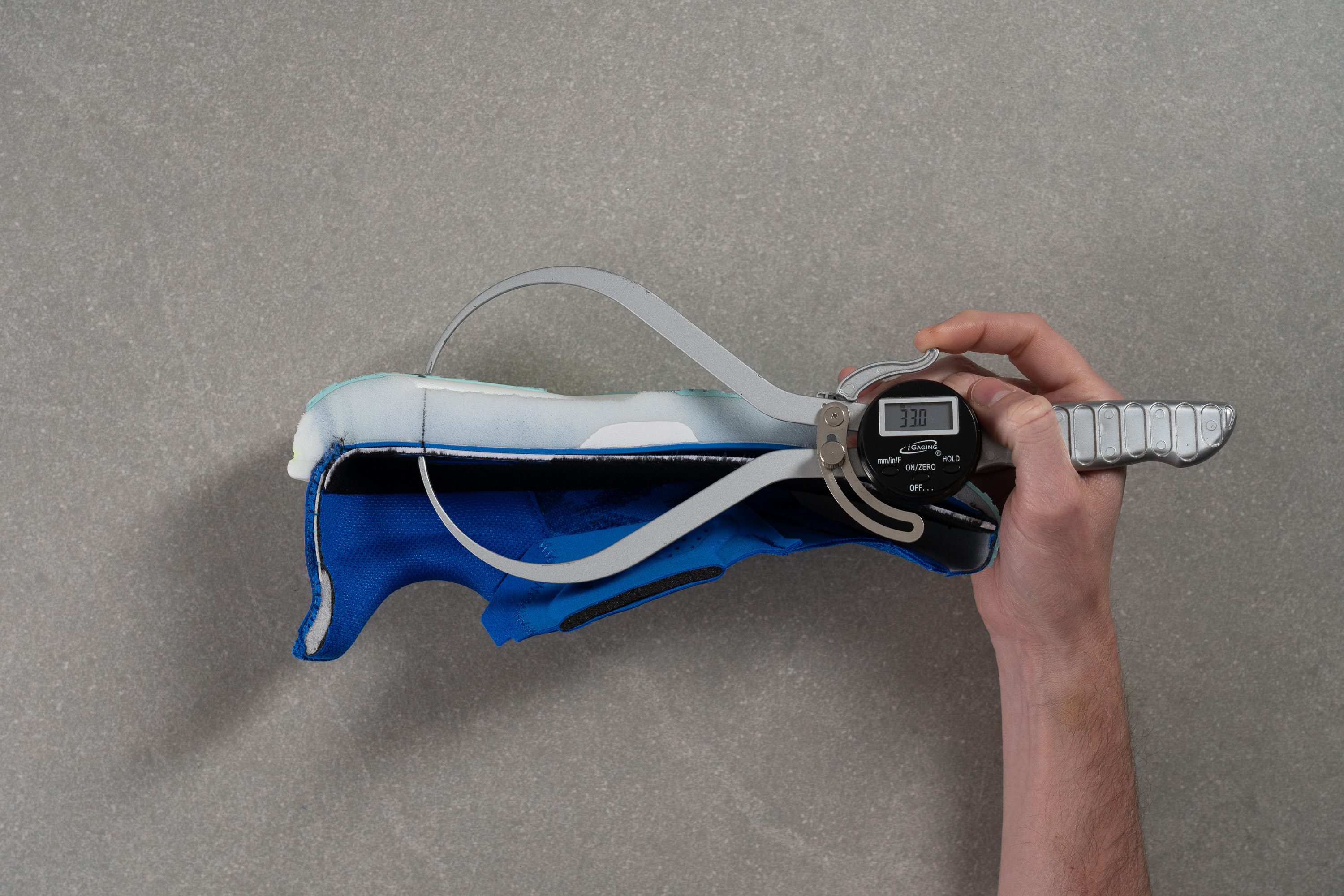
| Hyperion GTS 2 | 33.0 mm |
| Average | 34.8 mm |
Forefoot stack
This is even more obvious in the forefoot, where we only measured 22.3 mm. Runners looking for a super-high-stack shoe should skip this one, but forefoot strikers who enjoy a close-to-the-ground ride will absolutely love the Hyperion GTS 2.
For better or worse, this is a different kind of shoe compared to modern daily trainers like the Nike Vomero 18.

| Hyperion GTS 2 | 22.3 mm |
| Average | 26.1 mm |
Drop
Brooks claims an 8 mm drop from heel to toe, but we measured 10.7 mm. While the difference is small—grab a tape measure and see for yourself—it’s still a slight mismatch that actually makes the shoe a bit more inviting to heel strikers.

| Hyperion GTS 2 | 10.7 mm |
| Average | 8.6 mm |
Midsole softness
The Hyperion GTS 2 comes with Brooks' updated DNA Flash v2 midsole, which we found to deliver a springy and fast-moving ride. This upgrade is a huge shift from the original Hyperion GTS, which used the first version of DNA Flash and felt a bit more muted underfoot.
We tested the midsole and recorded 20.0 HA on our durometer—giving it a moderately-cushioned, firm-enough feel. Going ultra-soft would likely have been the wrong move in a low-stack, mild-stability shoe like this, as you want a supportive platform that keeps you in control without bottoming out.
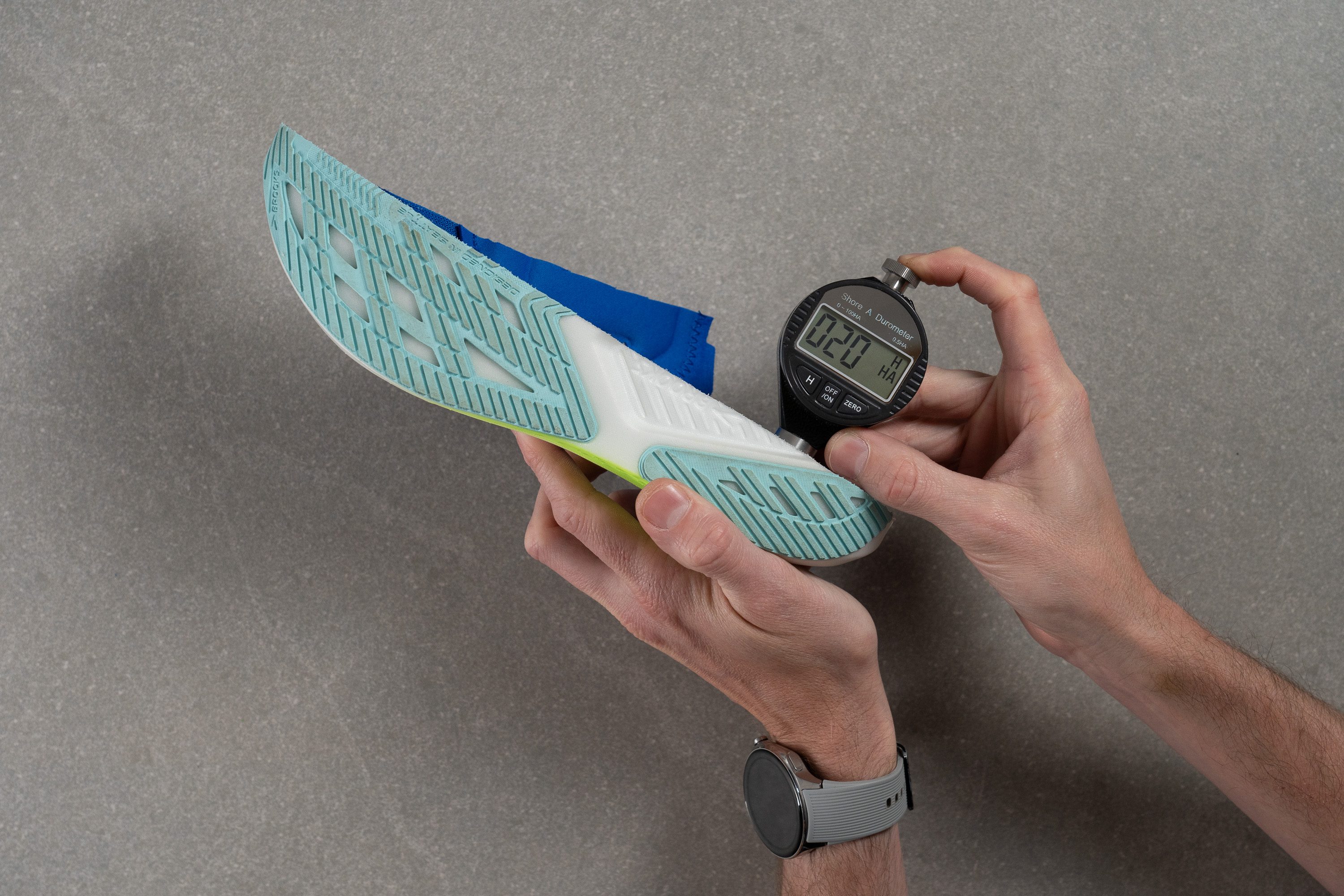
| Hyperion GTS 2 | 20.0 HA |
| Average | 20.4 HA |
Rocker
Another update in the Hyperion GTS 2 is the added curvature in both the heel and forefoot. It’s a subtle design shift that may not please every runner, but the ride remains smooth and natural-feeling.
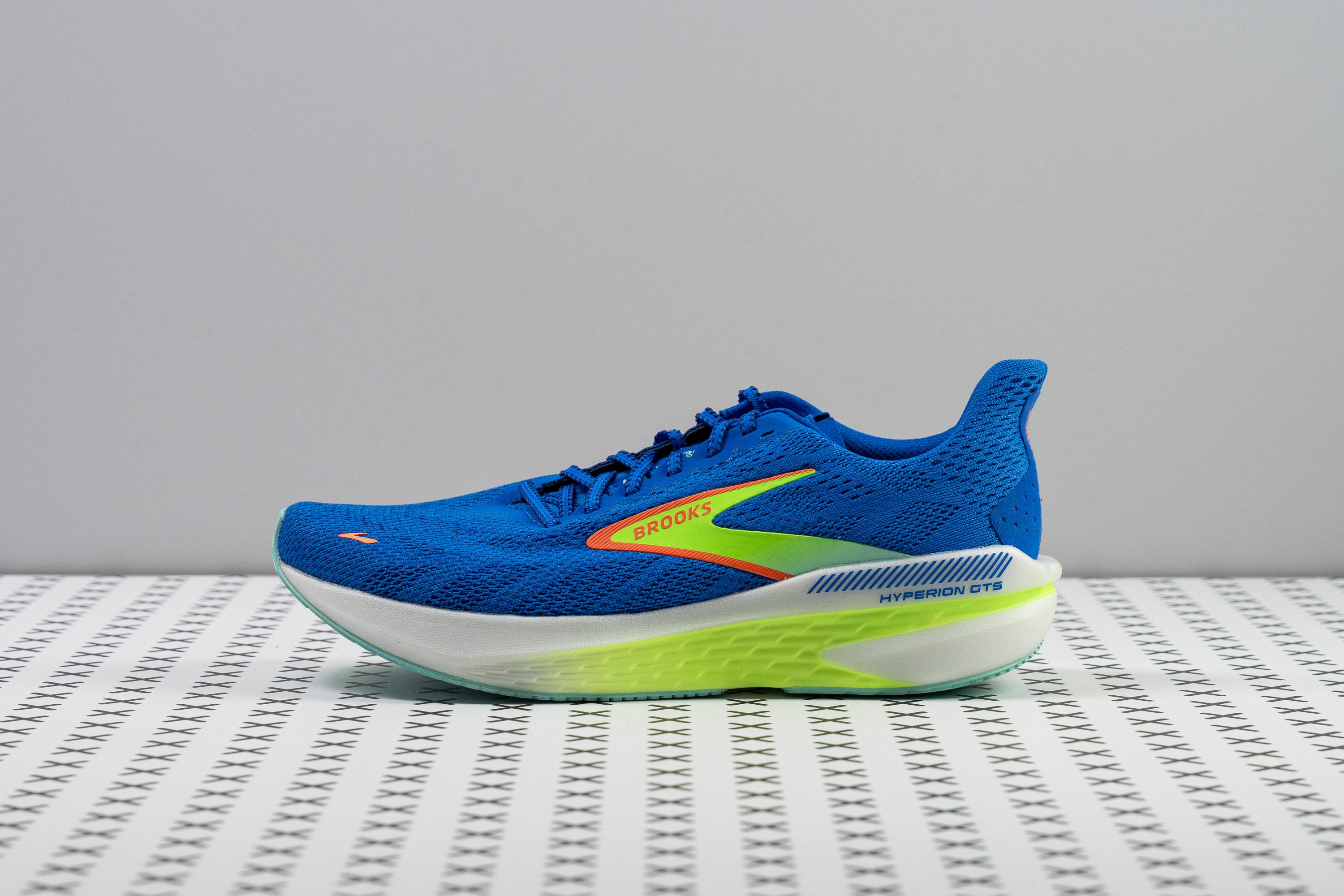
We checked it and noticed a smooth-rolling sensation that felt more noticeable than before. But again, not a deal-breaker for fans of version 1.
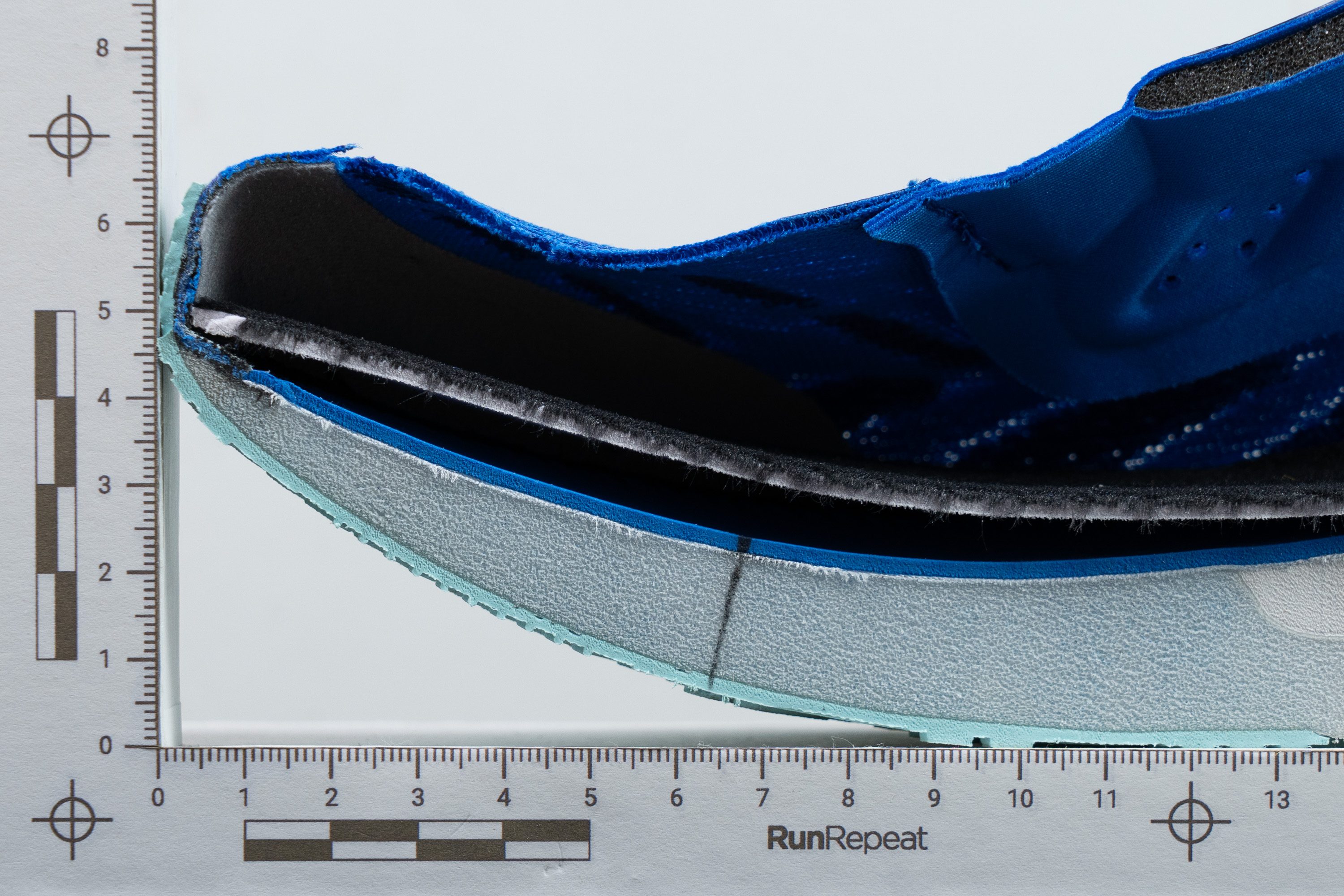
Size and fit
Size
Brooks Hyperion GTS 2 fits true to size (103 votes).
Width / Fit
We poured liquid into the shoe to create a gel replica, allowing us to take as many measurements as needed to study the fit.
With 93.8 mm in the widest part, the shoe is slightly narrower than the average—but only by a hair. If you usually do well in most running shoes, this part of the Hyperion shouldn’t be a problem.
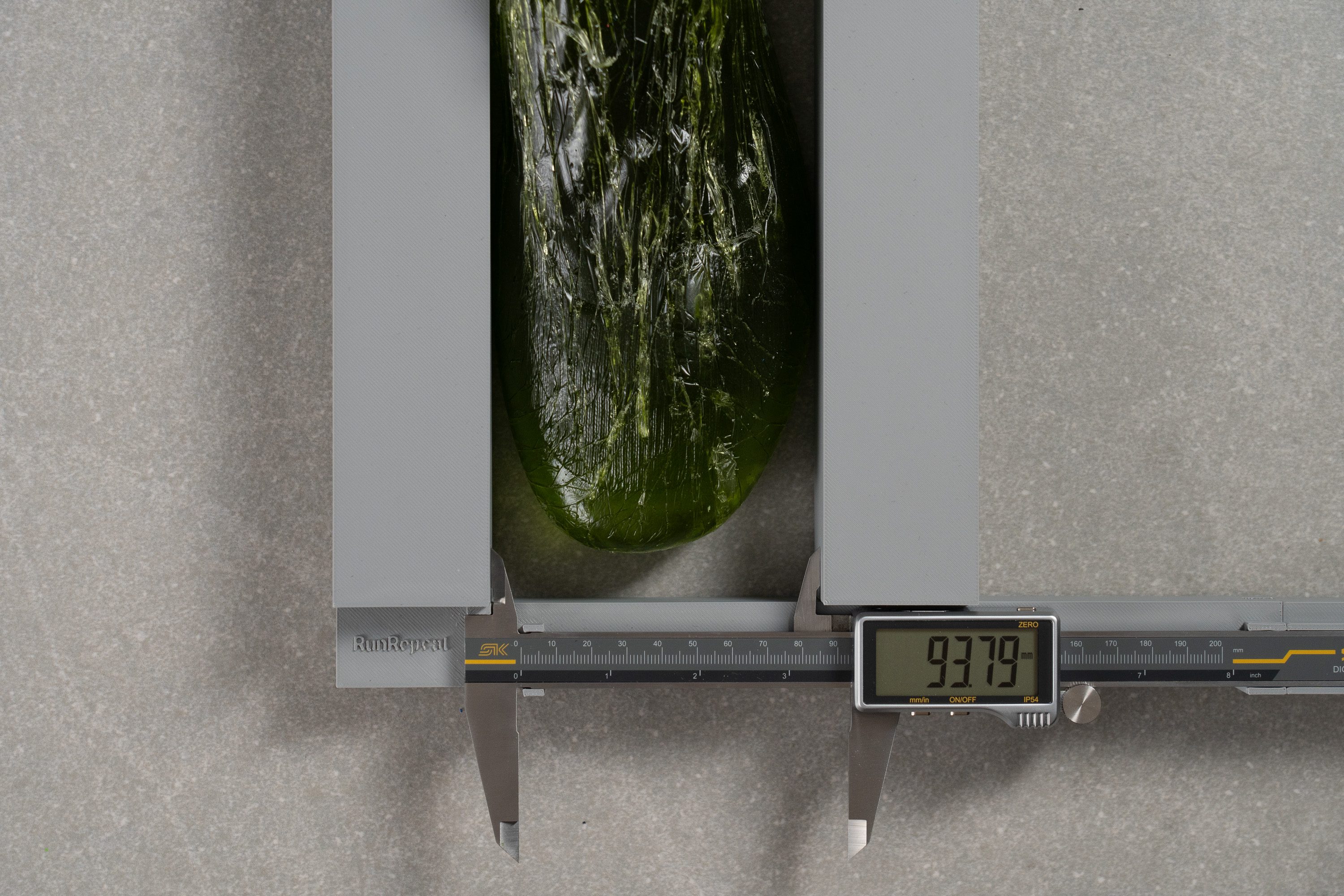
| Hyperion GTS 2 | 93.8 mm |
| Average | 95.1 mm |
Toebox width
We took a second measurement of the toebox width and got 72.7 mm. Once again, it’s just a tiny step away from the average running shoe, so it should work for most runners. However, if your feet are extremely narrow or wide, the fit might feel a bit off.
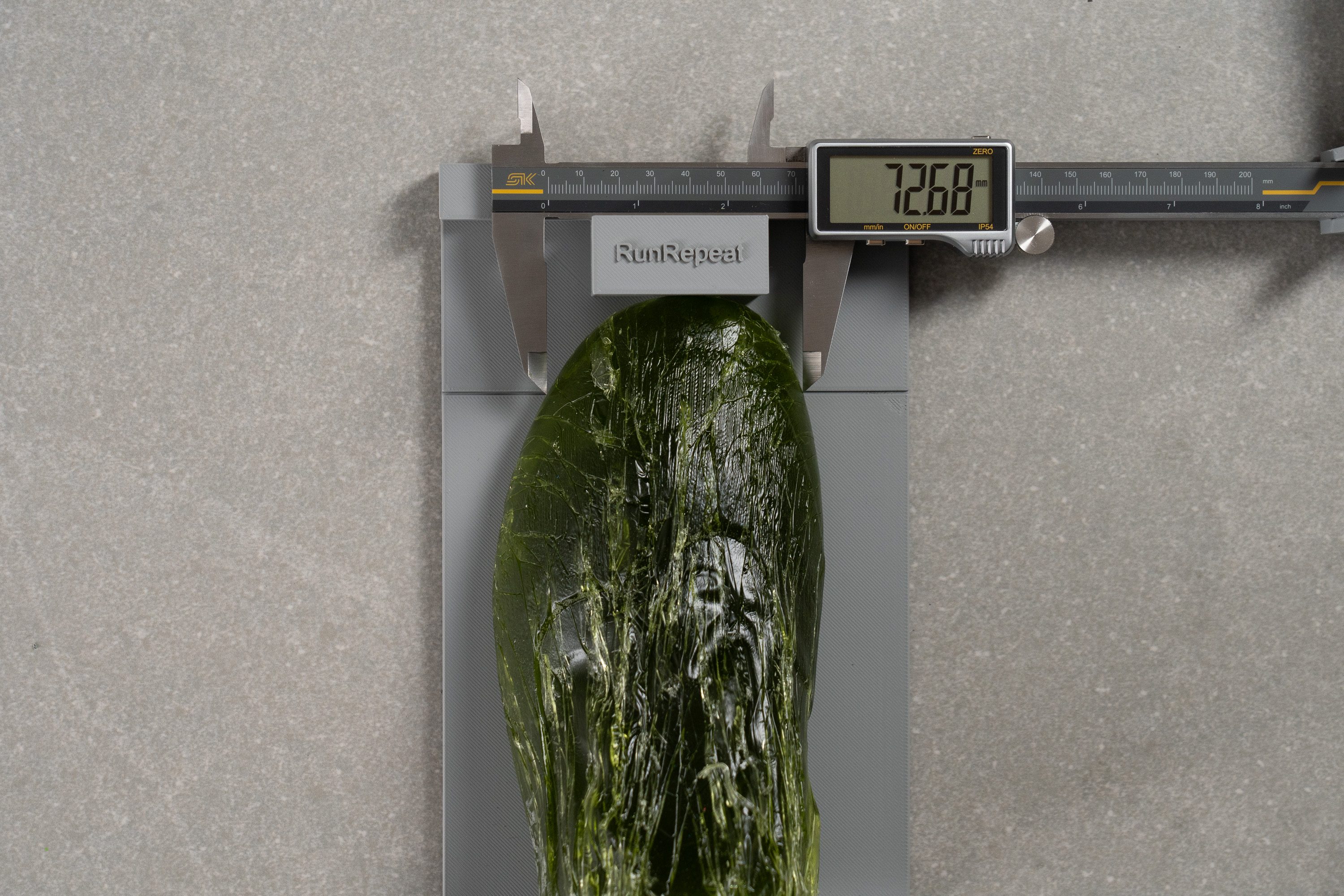
| Hyperion GTS 2 | 72.7 mm |
| Average | 73.3 mm |
Toebox height
We found generous clearance for the toes at 30.3 mm—quite impressive and great for daily runs.
However, runners who prefer a snug, race-like fit might feel it’s a bit too roomy.

| Hyperion GTS 2 | 30.3 mm |
| Average | 27.1 mm |
Traction / Grip
Traction test
The Hyperion GTS 2 is here to keep you surefooted even if it rained the night before and the sidewalks are still wet.
Measuring its gripping capacity with a SATRA TM144 method, we recorded the shoe's coefficient of friction at 0.46. It may not be the tackiest grip among all tempo shoes, but it offers a good bite for cornering on both dry and wet concrete skid-free.
| Hyperion GTS 2 | 0.46 |
| Average | 0.47 |
Outsole design
We were pleasantly surprised by the generous rubber coverage on the Hyperion GTS 2, especially given its lightweight build. Brooks somehow managed to deliver a well-protected outsole with strategic segmentation across the forefoot and heel. Despite the minimal weight, the design includes plenty of rubber.
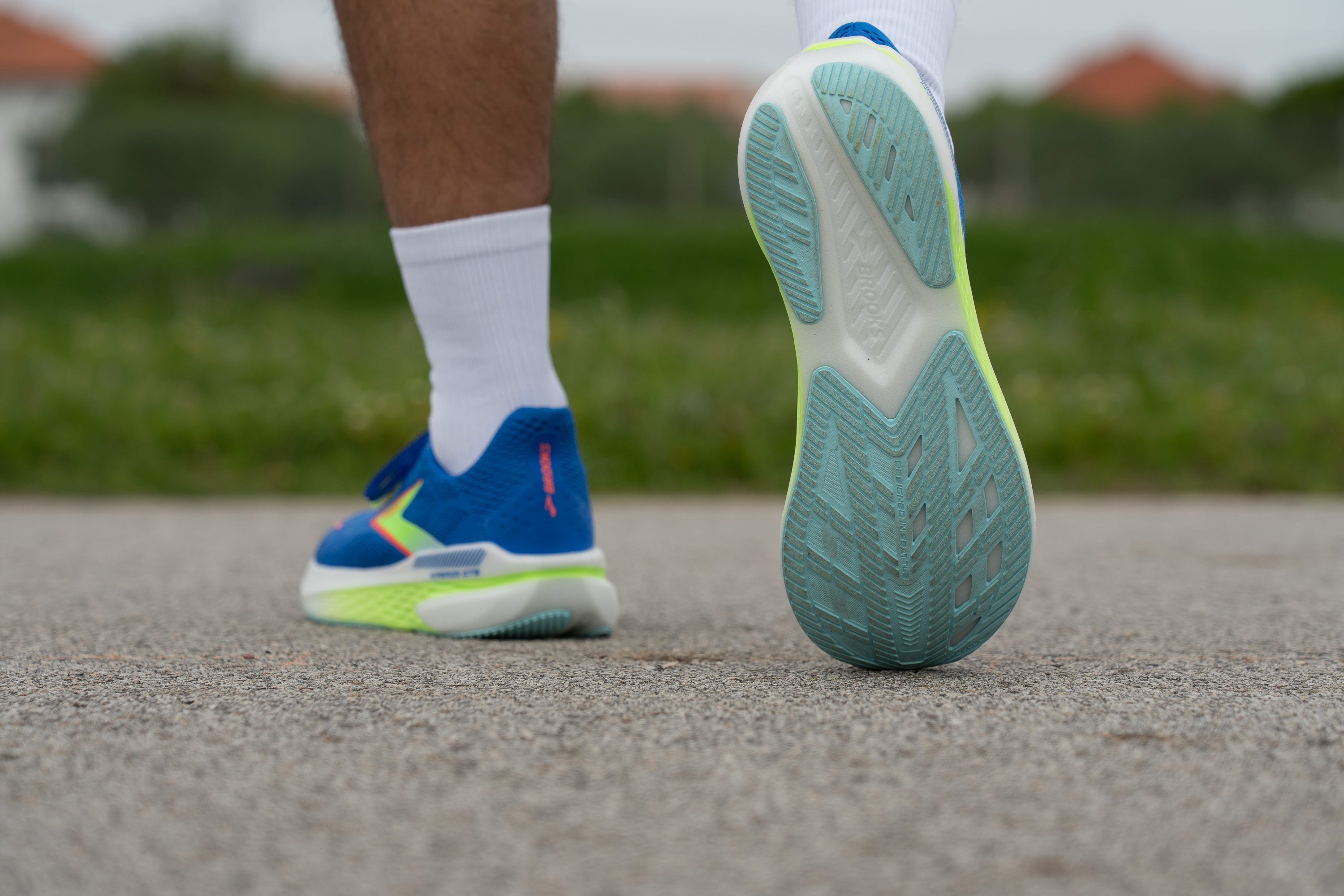
Flexibility / Stiffness
We were glad to see that it remains moderately flexible, making it a good match for everyday wear too. The non-GTS version scored 13.0N in this same test, and we now measured 12.6N—a rare case where the stability version brings a touch more flex!
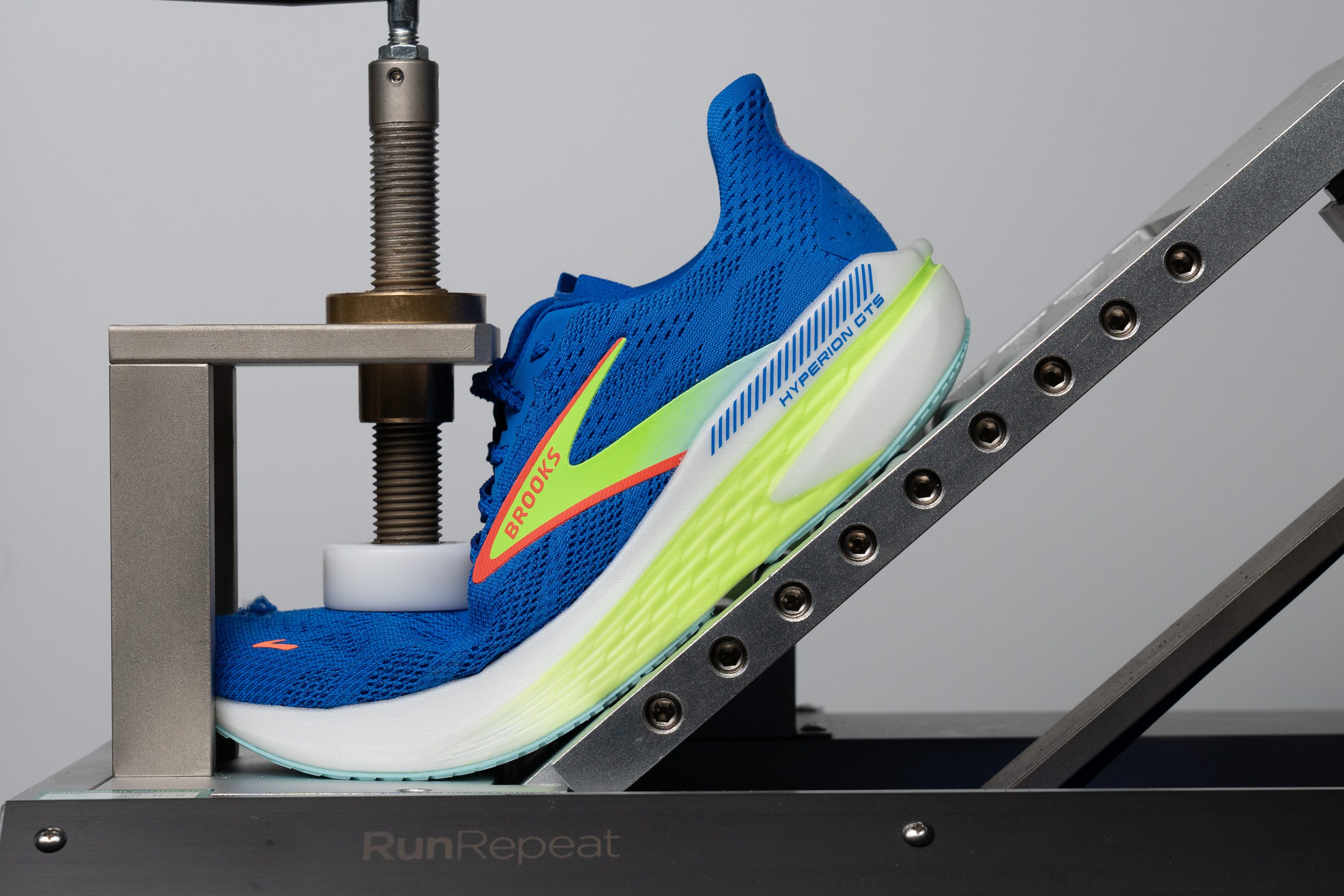
| Hyperion GTS 2 | 12.6N |
| Average | 15.2N |
Weight
The addition of stability elements like the GuideRails leads to a small 8% weight increase over the standard model. However, at 7.8 oz or 220g, it’s still a lightweight shoe that keeps the Hyperion series’ spirit alive, and it even drops a few grams compared to its predecessor.

| Hyperion GTS 2 | 7.8 oz (220g) |
| Average | 9.3 oz (265g) |
Breathability
We found in the lab that the Hyperion GTS 2 handles airflow well enough to score 3 out of 5 in our breathability test. That means it should feel comfortable and airy during most runs—unless you're facing heat-heavy weather.
To understand this better, we moved the upper across a bright light. That helped us spot several mesh openings that allow hot air to escape. This design choice explains how the shoe maintains at least decent airflow in real-world conditions.
We then inspected the mesh under our digital microscope.
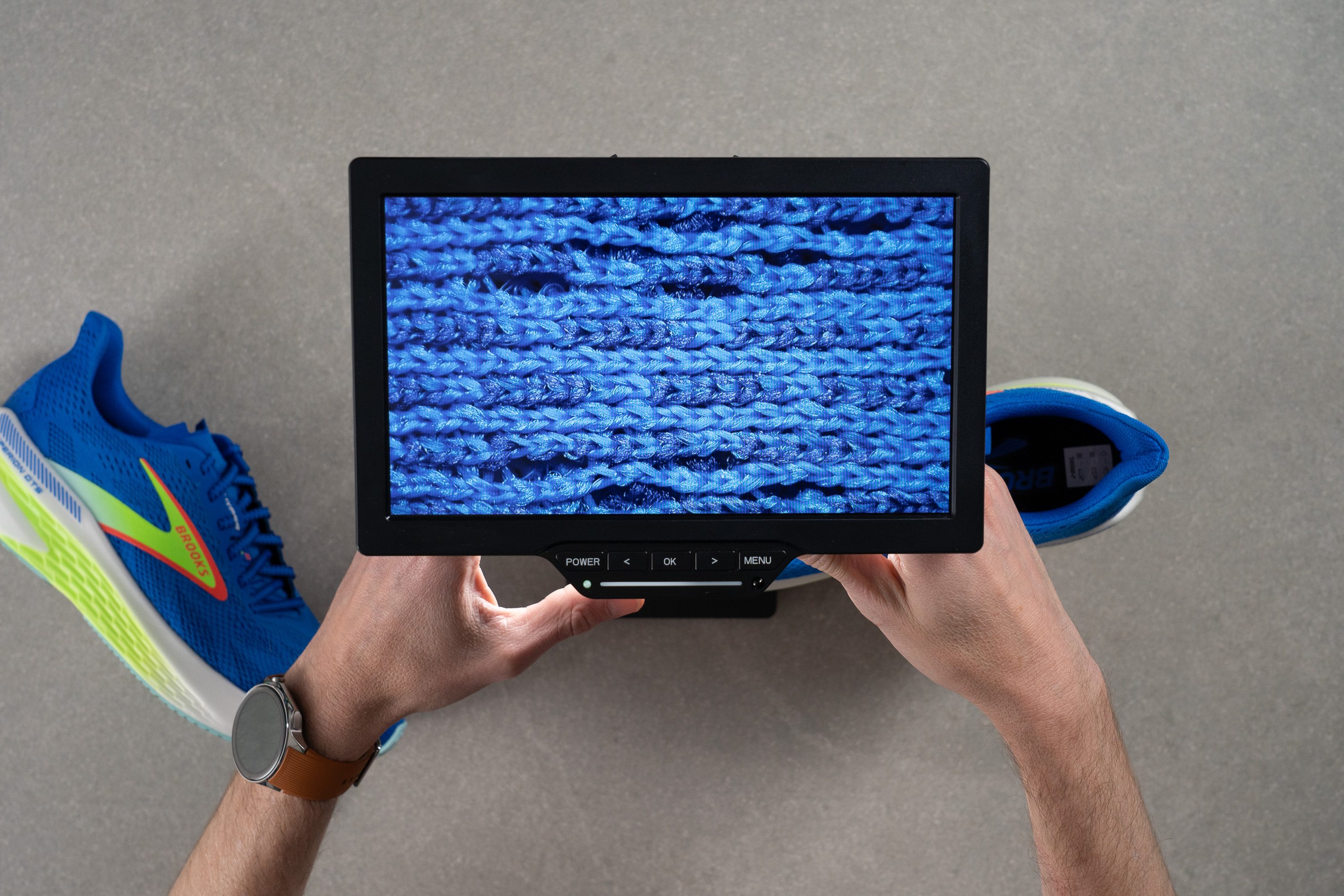
What we discovered is that Brooks used a dual-layer construction, which slightly limits ventilation compared to single-layer designs. A thinner, single-mesh setup would have breathed better but likely worn out faster.
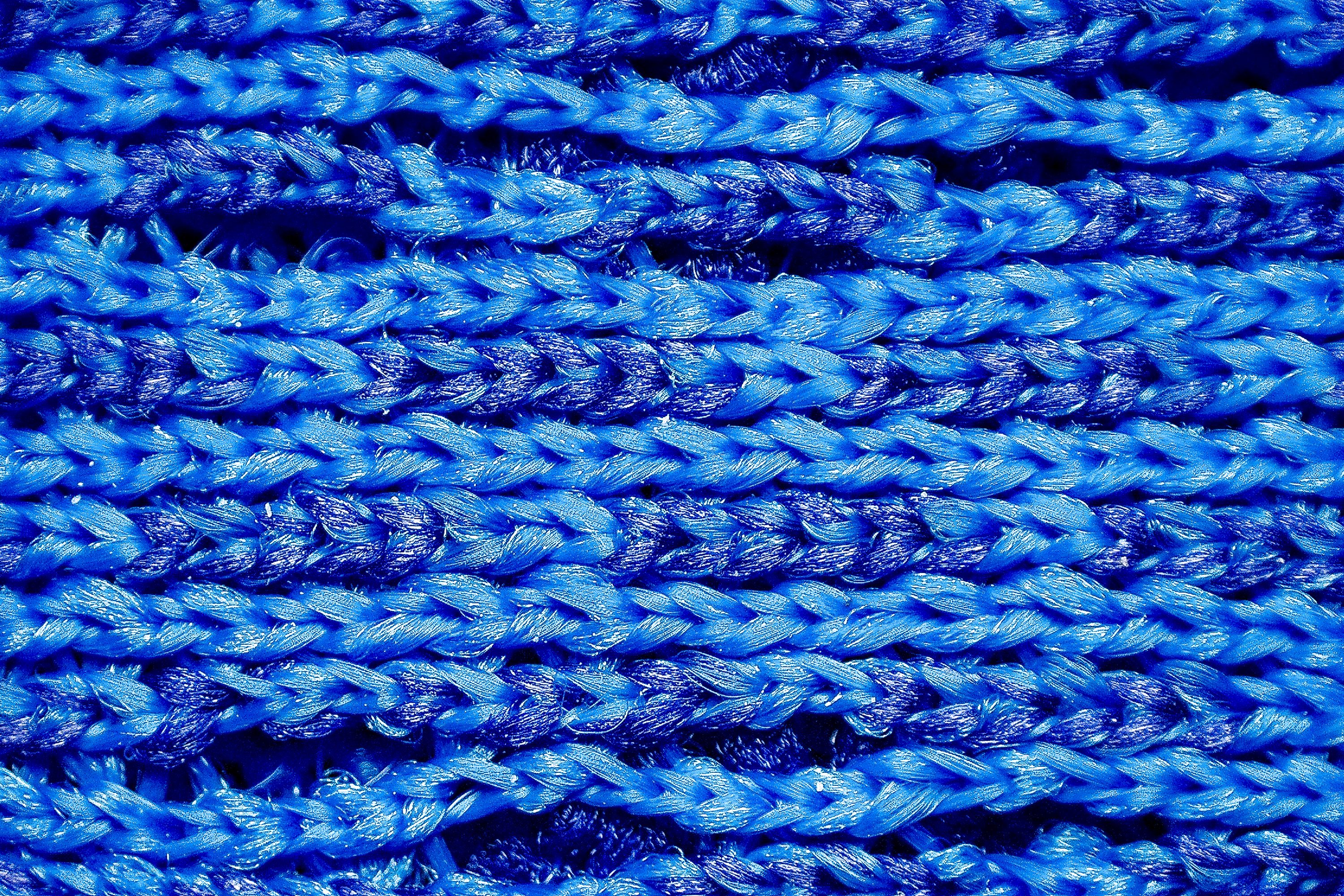
In this case, Brooks chose a longer-lasting approach, leaning into an more durable build rather than chasing maximum airflow.
Lastly, we manually checked the full upper and noticed that the heel and tongue offer some comfort-oriented padding. It’s not as plush as a classic daily trainer, but it’s noticeably lighter.
| Hyperion GTS 2 | 3 |
| Average | 3.7 |
Stability
Lateral stability test
Incorporating Brooks' GuideRails support system, the Hyperion GTS 2 provides extra stability, guiding the foot without being intrusive.
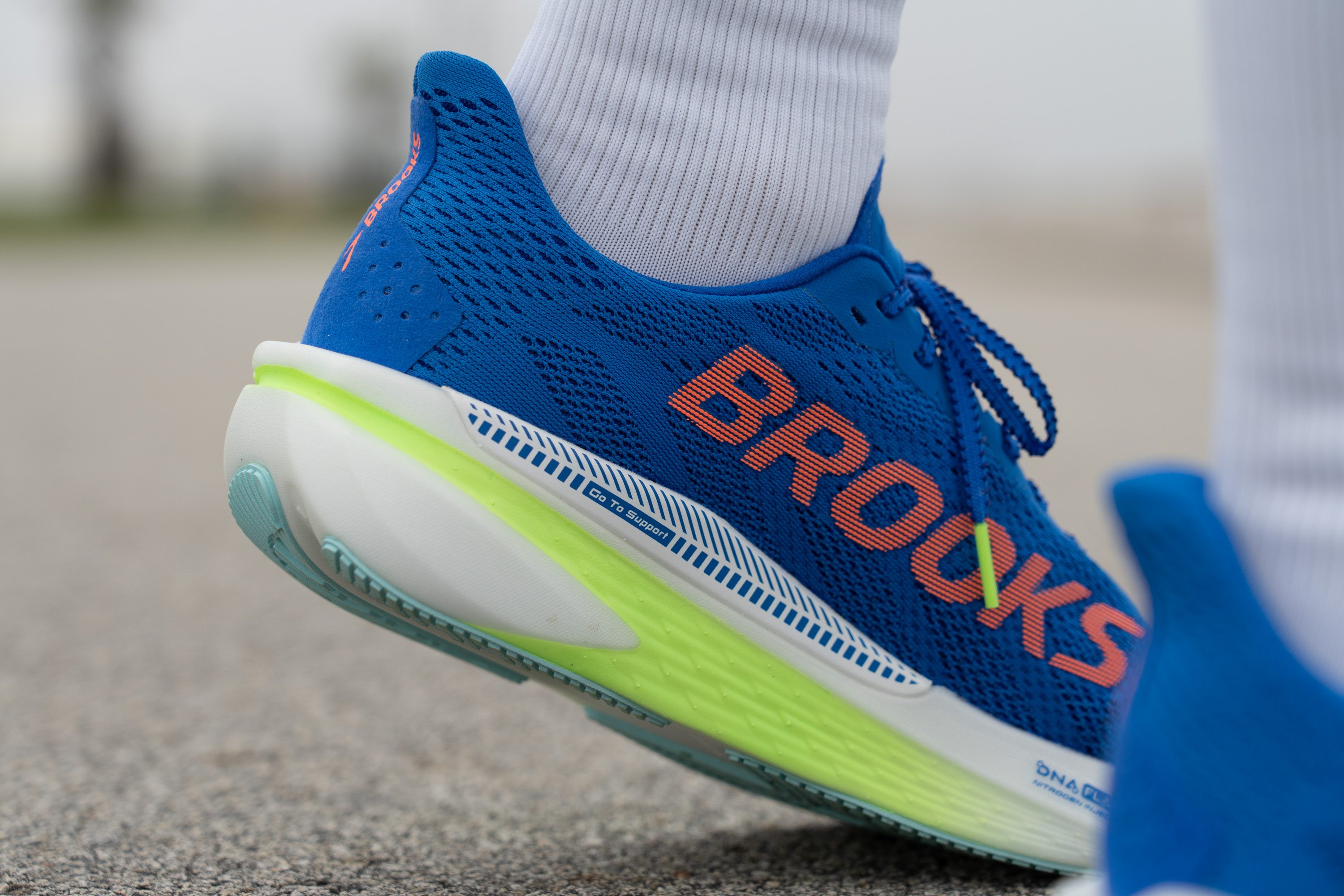
This makes it suitable for runners who need mild support during faster runs. However, those with high stability needs may want to check the Glycerin GTS 22.
Torsional rigidity
The addition of the GuideRails bumps the torsional rigidity to 4/5, up from the 3/5 we measured in the regular Brooks Hyperion 2. It’s not a major change, and most runners won’t even notice it.
| Hyperion GTS 2 | 4 |
| Average | 3.5 |
Heel counter stiffness
We tested the heel counter and found it's the same of the non-GTS version—built like what you'd expect in an average daily trainer, with a 3/5 score. Its semi-rigid design adds just enough stability for rearfoot strikers without leaning too firm.
| Hyperion GTS 2 | 3 |
| Average | 2.9 |
Midsole width - forefoot
One thing we hope never changes in the Hyperion series is agility. In a market packed with cushion-loaded shoes that feel like tanks underfoot, this series stays sleek even in the stability version, making it a joy to run in.
We tested the forefoot and measured 112.3 mm at the midsole, which lines up perfectly with its DNA.
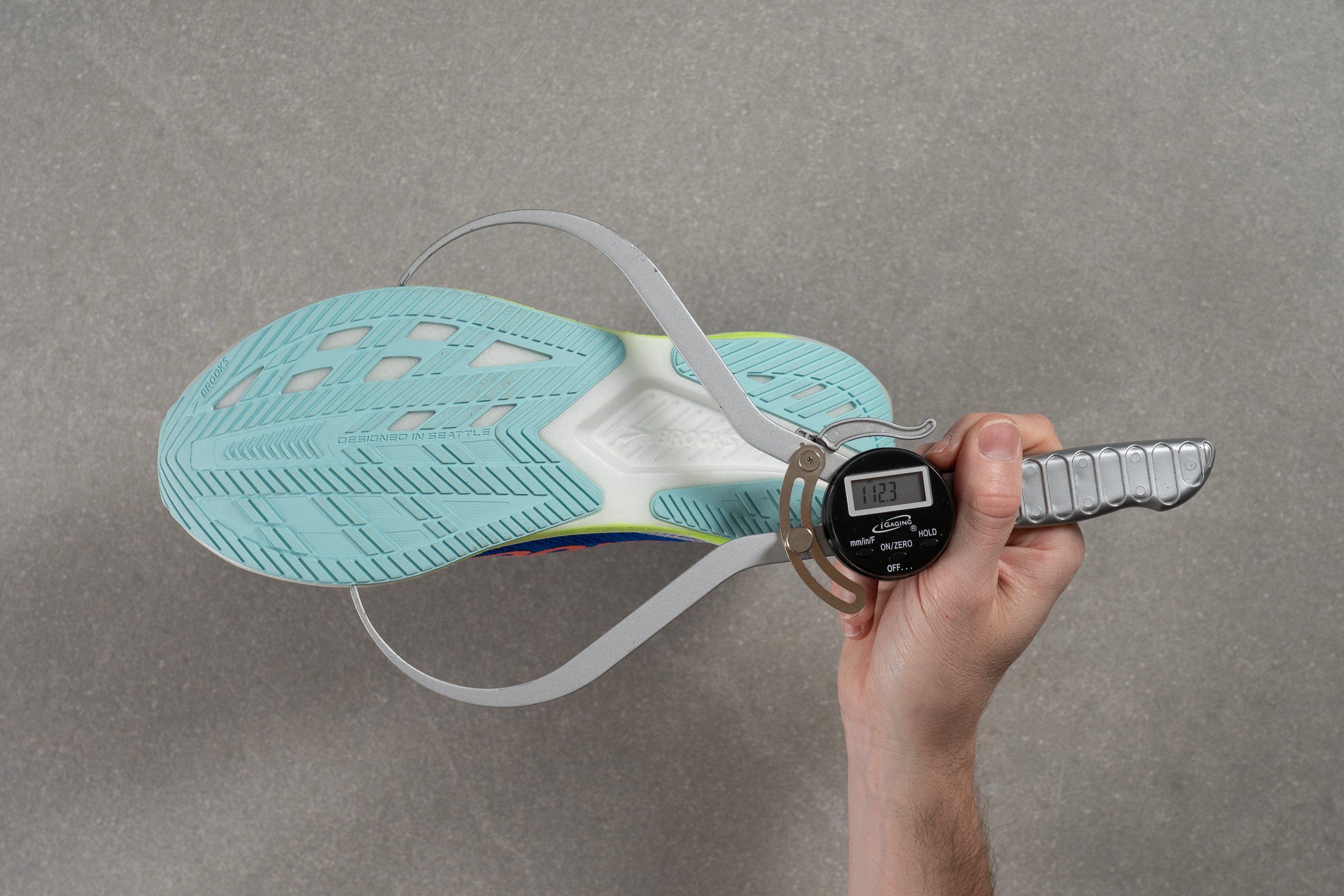
| Hyperion GTS 2 | 112.3 mm |
| Average | 114.3 mm |
Midsole width - heel
Despite being a stability shoe, the heel is quite narrow at 86.7 mm. As we mentioned earlier, the Hyperion is an agile-and-lightweight model that skips the wide-midsole formula and gets its moderate stability from other design choices.
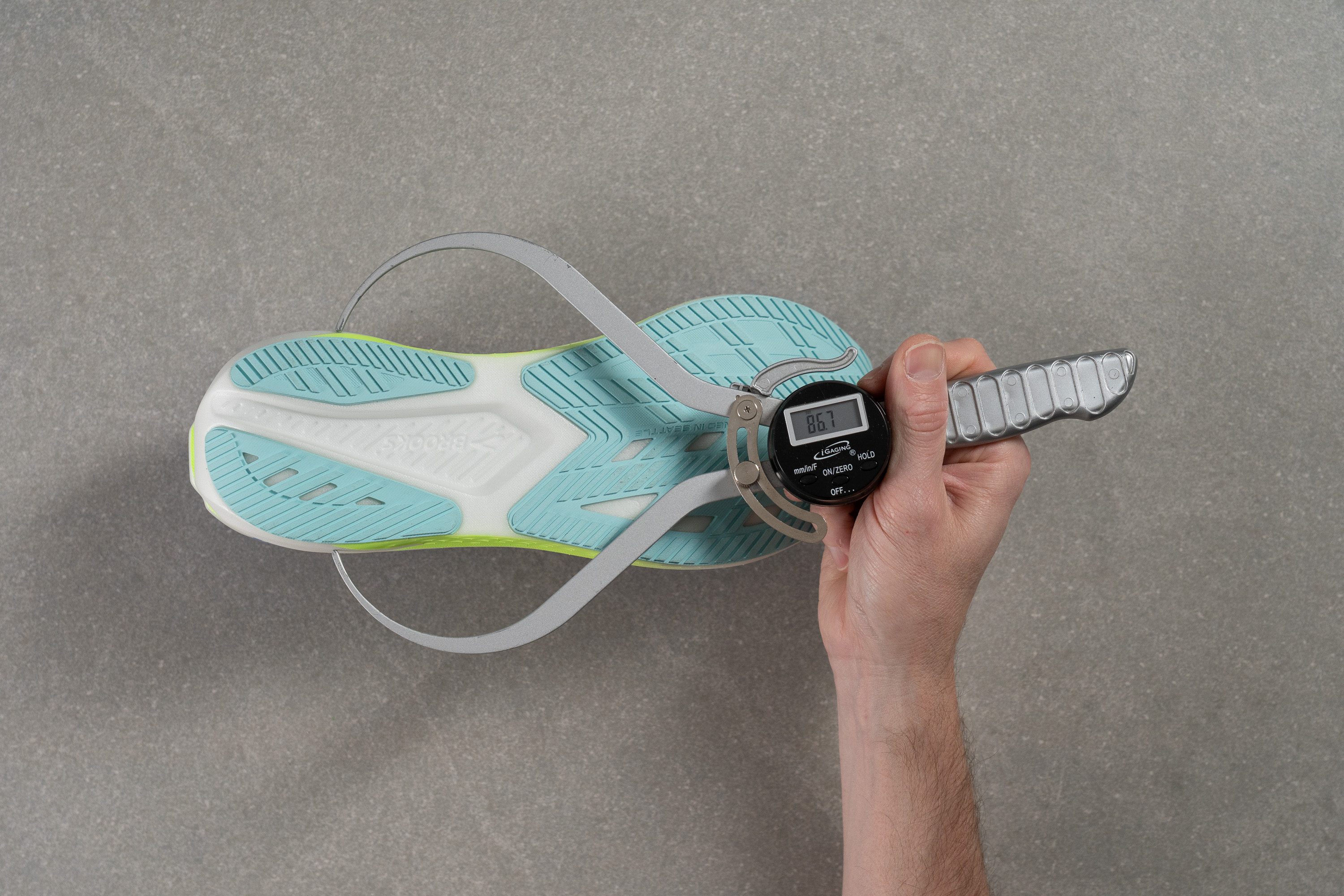
| Hyperion GTS 2 | 86.7 mm |
| Average | 90.7 mm |
Durability
Toebox durability
Thanks to the dual-layer mesh we mentioned earlier, the Hyperion GTS 2 earned a solid 3/5 in our Dremel test. This points to good durability, and the upper should outlast or match the rest of the shoe.
| Hyperion GTS 2 | 3 |
| Average | 2.6 |
Heel padding durability
The heel padding showed strong performance in our test, outlasting the upper and scoring 4 out of 5. Because of this, we believe runners won’t need to worry about wear and tear in this area.
| Hyperion GTS 2 | 4 |
| Average | 3.4 |
Outsole durability
The outsole did well. We tested it and found just 0.8 mm of wear after lifting the Dremel—proof that this shoe offers good durability, quite similar to what most average daily trainers deliver. And this result matters even more because the shoe is designed for runners with pronation issues, often known for being rougher on outsoles.
| Hyperion GTS 2 | 0.8 mm |
| Average | 1.1 mm |
Outsole thickness
We also measured the outsole thickness at 3.3 mm. That’s possibly a bit much for a shoe built around weight savings, especially since the rubber holds up well, but nothing alarming or overbuilt.
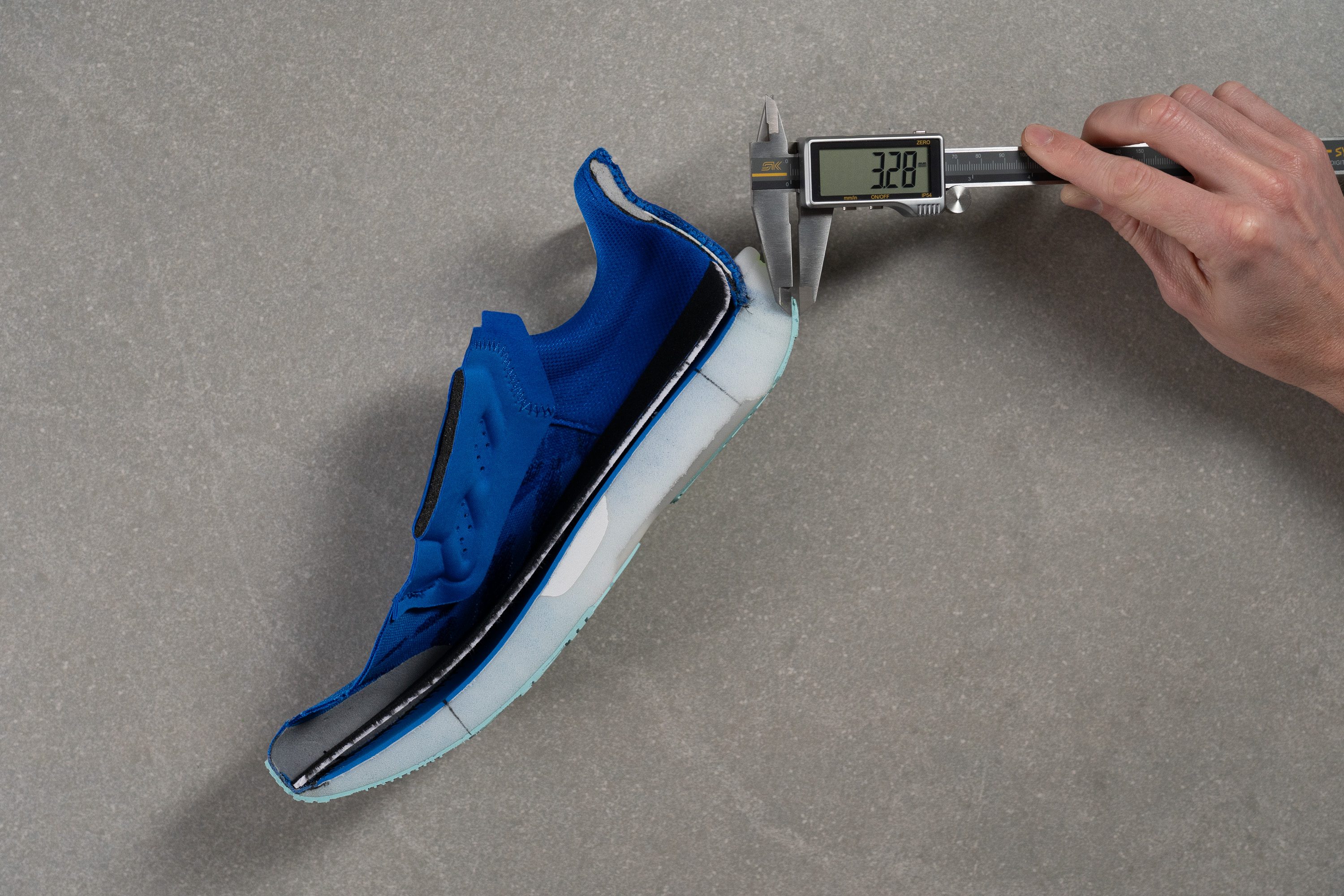
| Hyperion GTS 2 | 3.3 mm |
| Average | 3.2 mm |
Misc
Insole thickness
The insole reflects the shoe’s stripped-down design with a feather-light build and minimal padding, adding just 2.8 mm of extra cushioning to the overall setup.
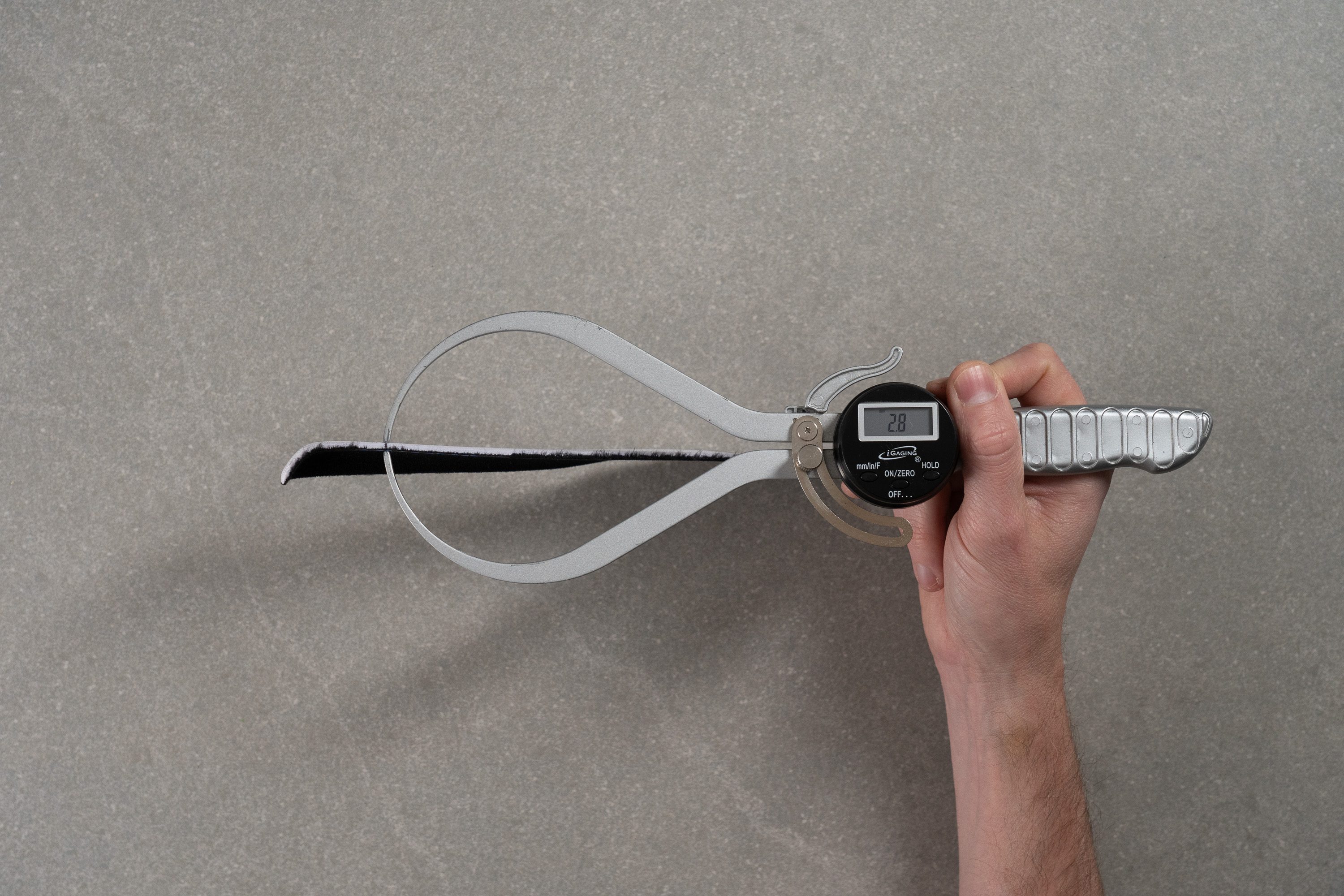
| Hyperion GTS 2 | 2.8 mm |
| Average | 4.5 mm |
Removable insole
If you want to add a bit more cushioning to the Hyperion GTS 2, just remove the razor-thin insole and slide in a thicker one. Thanks to the generous vertical clearance, this comfort-boosting swap is totally doable.
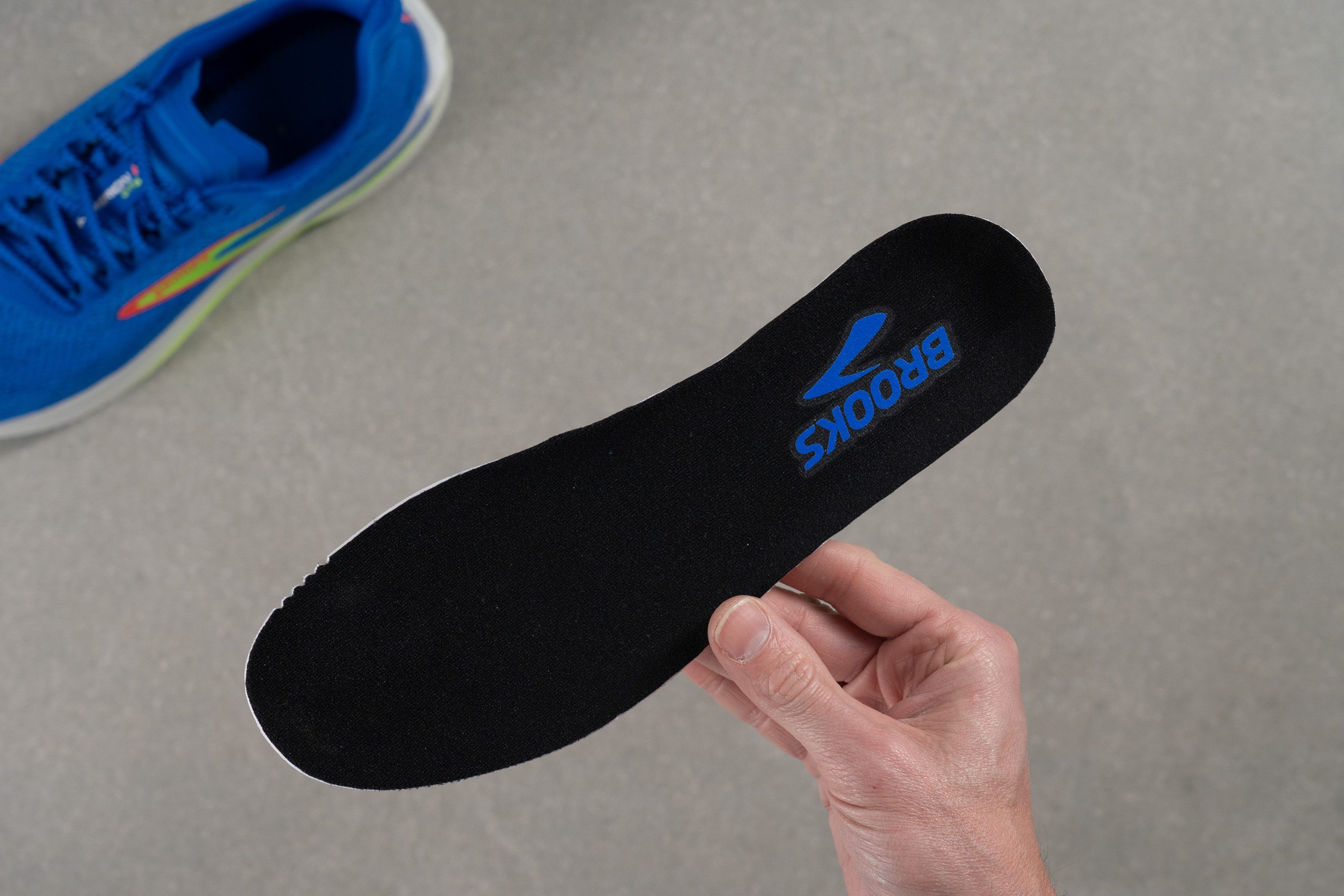
| Hyperion GTS 2 | Yes |
Midsole softness in cold (%)
DNA Flash v2 may be new to this shoe, but it’s still a foam that sits outside the premium tier—so we weren’t surprised to see an average 30% change in our cold-weather freezer test.

| Hyperion GTS 2 | 30% |
| Average | 25% |
Reflective elements
One of the few misses on the Hyperion GTS 2 is the lack of reflective elements. And while most runners might not mind, we definitely do!
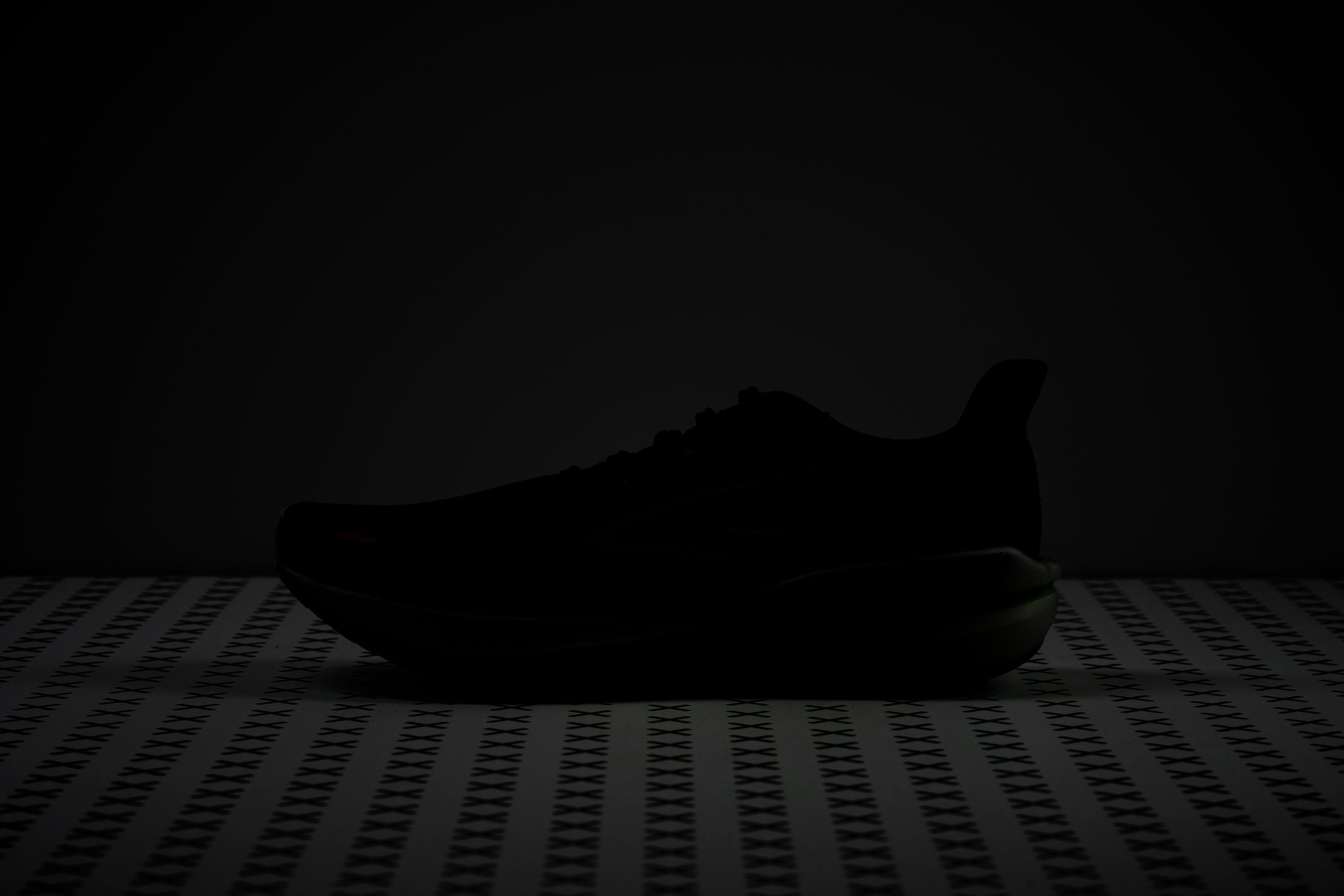
| Hyperion GTS 2 | No |
Tongue padding
The textured laces are a standout detail for a shoe that’s not priced in the premium range, and the entire lacing system feels secure and really well designed.

The tongue padding also deserves praise—it shows that Brooks put real care into crafting a lightweight, tempo-friendly trainer. Instead of stuffing it with a thick slab of foam like most brands do, they placed 5.8 mm of cushioning only where it matters most.

| Hyperion GTS 2 | 5.8 mm |
| Average | 5.8 mm |
Tongue: gusset type
It was great to discover that the tongue features a semi-gusseted design. In other words—it’s partially attached, combining weight-saving simplicity with a secure lockdown that keeps the foot in place.
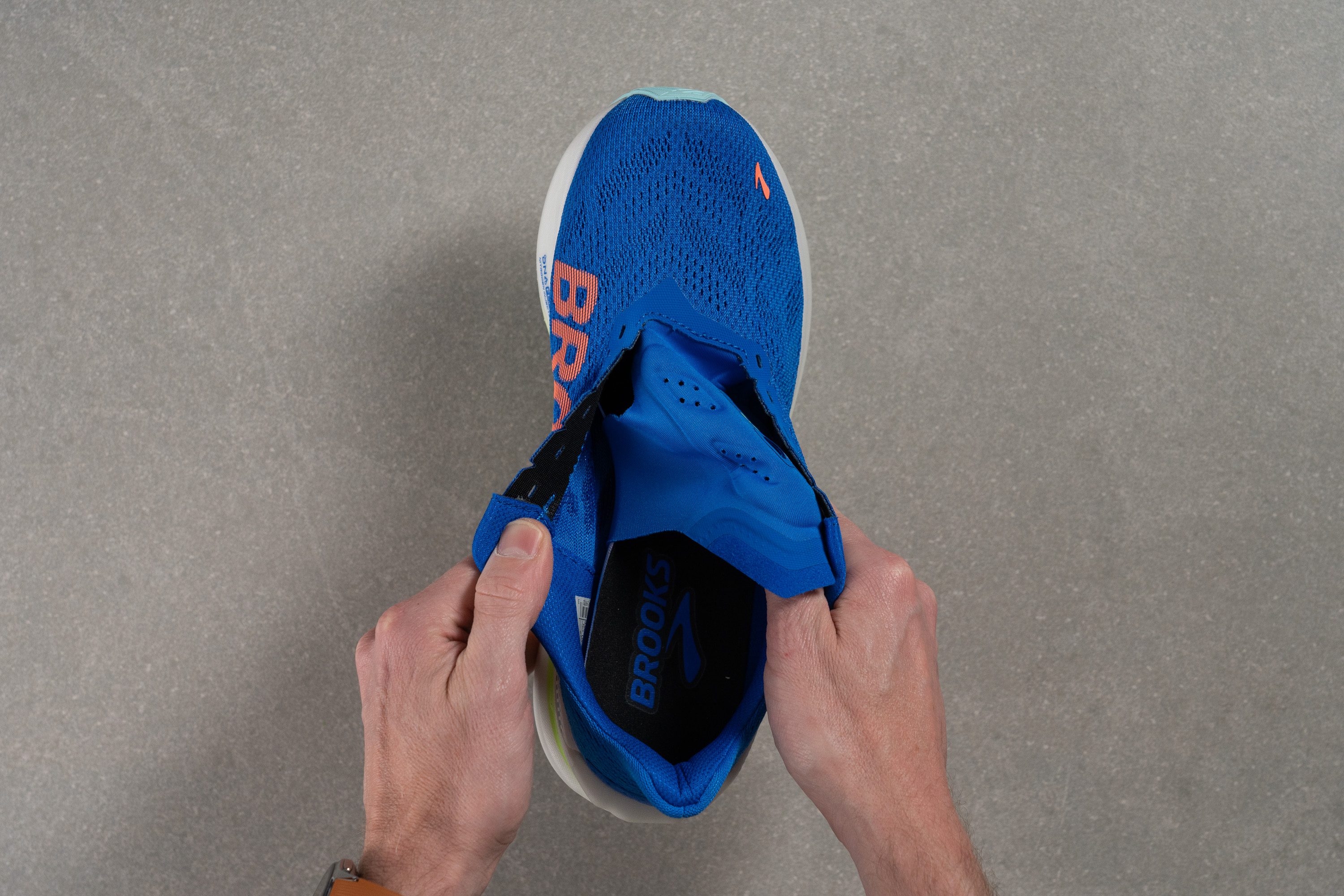
| Hyperion GTS 2 | Both sides (semi) |
Price
The price is one of the most appealing features of the Hyperion GTS 2. It’s a wallet-friendly option considering how fast and fun it feels, and we genuinely hope Brooks keeps this pricing approach in future versions.
| Hyperion GTS 2 | $140 |
Heel tab
The heel features an extended collar design, quite similar to what we’ve seen in several HOKA running shoes.
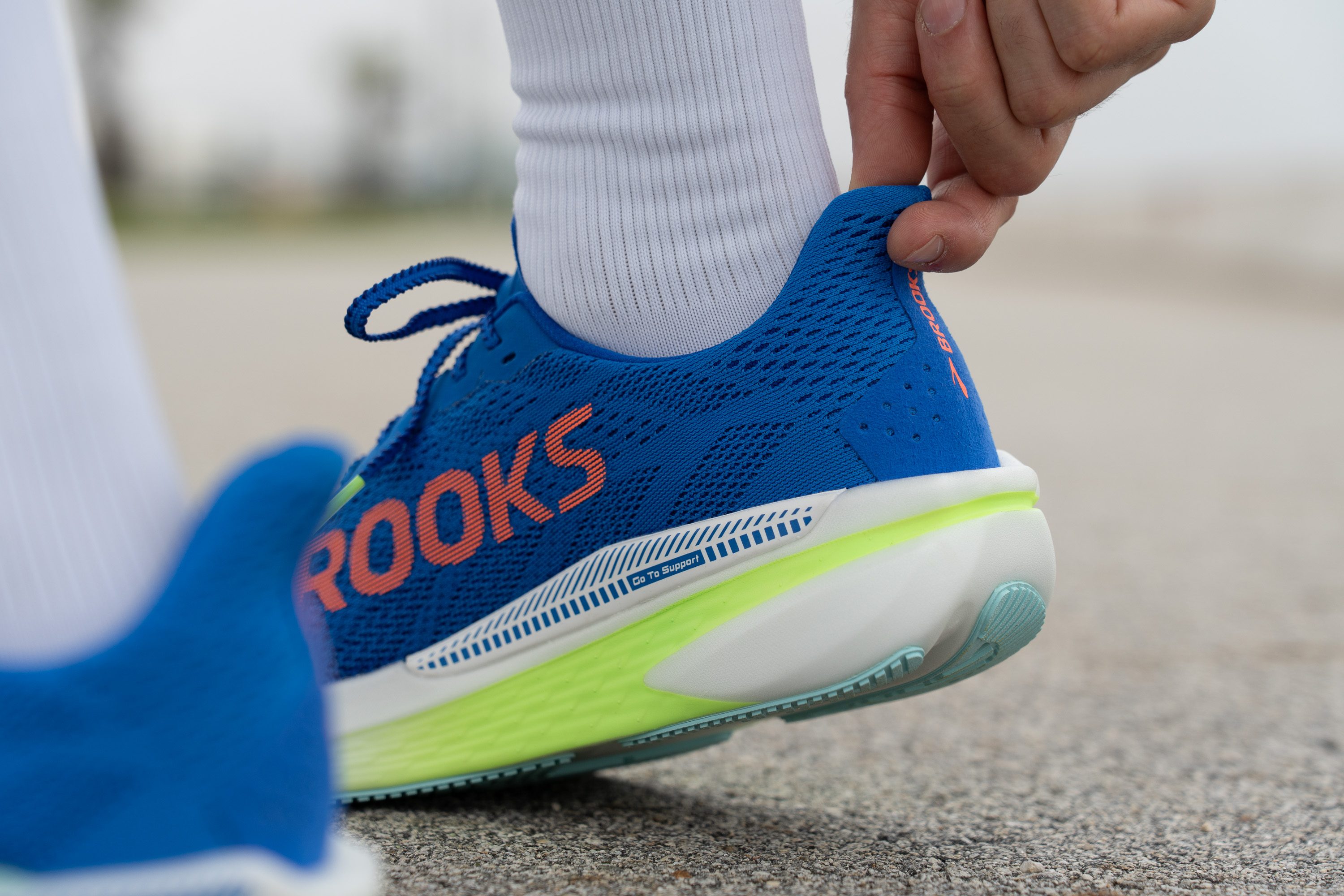
| Hyperion GTS 2 | Extended heel collar |

